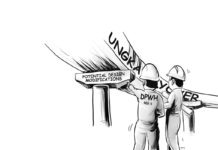
[av_textblock size=” font_color=” color=” av-desktop-hide=” av-medium-hide=” av-small-hide=” av-mini-hide=” av-medium-font-size=” av-small-font-size=” av-mini-font-size=”]
[/av_textblock]
[av_one_full first min_height=” vertical_alignment=” space=” custom_margin=” margin=’0px’ padding=’0px’ border=” border_color=” radius=’0px’ background_color=” src=” background_position=’top left’ background_repeat=’no-repeat’ animation=”]
[av_heading heading=’EDITORIAL’ tag=’h3′ style=’blockquote modern-quote’ size=’30’ subheading_active=’subheading_below’ subheading_size=’15’ padding=’10’ color=” custom_font=” av-medium-font-size-title=” av-small-font-size-title=” av-mini-font-size-title=” av-medium-font-size=” av-small-font-size=” av-mini-font-size=” admin_preview_bg=”][/av_heading]
[av_textblock size=’18’ font_color=” color=” av-medium-font-size=” av-small-font-size=” av-mini-font-size=” admin_preview_bg=”]
THE GOVERNMENT’S plan to improve telecommunications services by bringing in new players and driving direct competition is most welcome.
The lack of effective competition in the sector has led to higher prices, poor quality or levels of service, and considerably less innovation – all at the expense of consumers. Just look at how slow our internet speed is.
We simply cannot allow ourselves to be forever at the mercy of only two dominant service providers. We should have multiple players persistently racing to beat each other in delivering superior communication and internet services at reduced prices.
In the United States, for example, at least five leading telecommunications players constantly improve their offerings to lure each other’s subscribers. Many Americans actually switch mobile telephone and broadband service providers every now and then because the options are getting diverse and better all the time.
Based on Akamai’s State of the Internet Report as of the first quarter of 2017, the Philippines’ 5.5 Mbps average connection speed pales when compared to Thailand’s 16 Mbps, Vietnam’s 9.5 Mbps, Malaysia’s 8.9 Mbps and Indonesia’s 7.2 Mbps.
Mbps is short for megabits per second – a measure of network transmission or data transfer speed. A megabit is equal to one million bits.
Worldwide, South Korea has the fastest average connection speed at 28.6 Mbps, while Paraguay has the slowest at 1.4 Mbps.
For years, the Philippines’ internet connection speed has been rated the slowest in Asia Pacific by Akamai Technologies Inc. The problem has prompted some lawmakers to push for the reclassification of internet service as a basic telecommunications provision so that regulators may compel nonstop upgrades under the pain of harsh administrative fines.
At present, internet service in the country is considered a “value-added service” beyond the regulatory powers of the National Telecommunications Commission.
So yes, let us break the country’s telecommunications duopoly.
[/av_textblock]
[/av_one_full]



